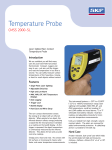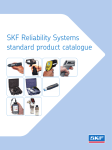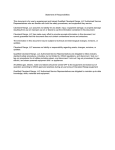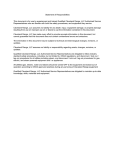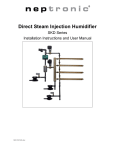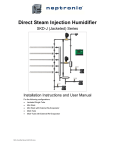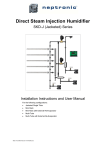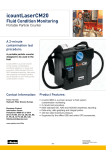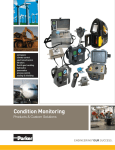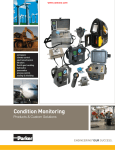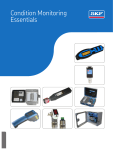Download Temperature Probe
Transcript
Temperature Probe CMSS 2000-SL Laser Sighted Non-Contact Temperature Probe Features • Proven method. • High and low alarms. • Calculates minimum, maximum, differential, and average temperatures. • Data Logging. • Expanded temperature range of -25°F to +1100°F (-30°C to +600°C). • Circular laser sighting to pinpoint the target. • Features automatic shut off. The non-contact thermometer senses the energy of an object with an infrared detector. The energy of the object consists of transmitted, emitted, and reflected energy enabling a user to assess the temperature of a bearing as it is operating. The thermometer lens, when pointed at an object, collects energy onto the infrared detector producing a signal that the microprocessor translates as a reading on the backlit display. As the trigger is squeezed, the object temperature is continuously measured by the infrared detector. This allows for fast and accurate real-time readings. Simply point, shoot and read. No contact with hot surfaces or moving parts means safer, faster, and easier temperature measurements. This instrument features a -25°F to +1100°F (-30°C to +600°C) temperature range; laser sighting; LCD backlight; MAX, MIN, ∆T, and AVG temperatures; recall last reading, HI and LOW audible and visual alarms; °C or °F selectable; low battery indicator; recall last reading; and adjustable emissivity. Units are molded from high-strength, solvent-resistant plastic. The optics are recessed for added environmental protection. A cable/strap anchor is provided for the belt clip. Hard Case A water resistant, dust-proof case which holds the unit (includes belt clip) and measures 9.6" x 6.6" x 2.0" (245mm x 169mm x 52mm) is included. 2 Temperature Probe CMSS 2000-SL www.skf.com/reliability Applications Find hot spots in electrical connections. Verify the temperature of asphalt, welded membranes and rooftop HVAC components. Measure a steamtrap line for temperature differences. Make sure that the diameter of the pipe fills the field-ofview. M EDO Find hot spots in motors and bearings. ED OM MODE 1 MODE M WATER PUMP OIL COOLER EDO CYLINDER LINERS OM RADIATOR THERMOSTAT HOUSING WATER BYPASS CYLINDER BLOCK 2 Examine temperature differences in engine blocks to eliminate costly breakdowns. How the Sensor Works Infrared thermometers sense the energy of an object, which consists of transmitted energy, emitted energy, and reflected energy. An infrared thermometer’s lens, pointed at an object, collects and focuses the energy onto an infrared detector inside the instrument producing a signal that the thermometer’s microprocessor translates and displays on the LCD. Some shiny or highly polished objects reflect infrared energy as well as emit it (transmitted energy for most objects is zero). Emissivity values quantify the emitting and reflecting characteristics of objects. The CMSS 2000-SL Temperature Probe can compensate for the object’s emissivity value when they calculate the emitted energy of the object. For most applications, objects being measured have high emissivities (painted, worn or oxidized metals, plastics, rubber, paper). It is not necessary to change the emissivity value, factory set at 0.95, for such applications. MODE ED CYLINDER HEAD Scan a moving surface to examine a dynamic thermal profile. AVOID EXPOSURE LASER RADIATION IS EMITTED FROM THIS APERATURE. EVITE EXPOSIÇÃO RADIAÇÃO LASER EMITIDA ATRAVÉS DESTA ABERTURA CAUTION LASER RADIATION - DO NOT STARE INTO BEAM OUTPUT < 1mW WAVE LENGTH 670 nm CLASS II LASER PRODUCT CAUTION RADIAÇÃO LASER - EVITE EXPOSIÇÃO DIRETA AOS OHLOS SAIDA < 1mW COMPRIMENTO DE ONDA 630-670 nm CLASSE II PRODUTO LASER 1mW FDA 21 CFR SUBCHAPTER J Class II (FDA) Laser Labels DE ACORDO COM FDA 21 CFR SUBCAPÍTULO J 670nm LASER RADIATION DO NOT STARE INTO BEAM CLASS 2 LASER PRODUCT PER IEC 825/91 OUTPUT < 1mW WAVE LENGTH 630-670 nm LASERSTRAHLUNG NICHT IN DEN STRAHL BLICKEN AUSGANGSLEISTUNG < 1mW WELLENLÄNGE 630-670 nm Class 2 (IEC) Laser Labels RAYO LASER SALIDA <1mW NO FIJAR LA VISTA EN EL RAYO LONGITUD DE ONDA PRODUCTO LASER CLASE 2 POR IEC 825/91 630-670 nm This instrument conforms to the following standards: • EN50081-1:1992, Electromagnetic Emissions • EN50082-1:1992, Electromagnetic Susceptibility Class 2 (JIS) Laser Label 2 LASER KLASSE 2 NACH IEC 825/91 NOTE Non-contact thermometers are not recommended for use in measuring shiny, polished, or unoxidized metals such as aluminum, brass, chromium and stainless steel. CW COMPLIES WITH RAYONNEMENT LASER SORTIE < 1mW NE PAS EXPOSER L’OEIL AU RAYON LASER LONGUEUR D’ONDE APPAREIL A LASER DE CLASSE 2 POUR LE IEC 825/91 630-670 nm 3 Temperature Probe CMSS 2000-SL www.skf.com/reliability Tests were conducted using a frequency range of 27 – 500 MHz with the instrument in three orientations. The average error for the three orientations is ± 1.0°C at 3 v/m throughout the spectrum. However, between 230 MHz and 500 MHz at 3 v/m, the instrument may not meet its stated accuracy. Display Scan or Hold Indicator Emissivity Value Laser On Indicator laser is made up of eight (8) laser spots, that form a circle to show the approximate area being measured called "spot size". A singular laser spot shows the center of the spot size. This spot size gets larger the farther away you are from the target. The ratio of the Distance-to-Spot Size, or D:S, is shown in the diagram below. The laser dot is offset 0.47 inches (12mm) above the target center. 24mm at 300mm Backlight On Indicator 30mm at 900mm 62mm at 1500mm Celsius or Fahrenheit Indicator Main Temperature Reading Low Battery Indicator High/Low Alarm Indicator Mode Indicator 0.9" at 12" 1.2" at 36'' 2.5" at 60'' Secondary Temperature and Alarm Set Points D:S = 30:1 at Focus Point Nominal spot diameter at 90% energy Sighting Groove Liquid Crystal Display (LCD) Recessed Optics Laser NOTE The unit measures the average surface temperature inside the measurement spot. Trigger Storing Data Battery Battery Compartment Cable/Strap Anchor Measuring Temperature Units measure the surface temperature of objects. To measure temperature, pull and hold the trigger while pointing at the target to be measured (See Distance and Spot Size). A temperature reading appears on the display. If the thermometer is subject to large changes in ambient temperatures (hot to cold or cold to hot), allow 30 minutes for temperature stabilization before taking measurements to ensure accuracy. Distance and Spot Size To achieve an accurate temperature reading, unit must be the correct distance from the targeted object. The circular The thermometer is capable of storing up to 12 data locations. The infrared temperature, temperature unit (°C or °F) and emissivity are also stored. Enhanced Modes The CMSS 2000-SL Temperature Probe feature adjustable HI or LO Alarm and adjustable emissivity. These units sense and update five temperature values simultaneously, each time you measure the temperature of an object. The values, which are stored in memory and can be recalled later, are current temperature, MAX temperature, MIN temperature, ∆T (difference between MAX and MIN), and AVG (average) temperature. • To Recall last reading. The unit will hold the last reading for 7 seconds. Release the trigger and press the Mode button (B). This is a “read-only” condition. By continually pressing Mode, you can cycle through all modes to review previous readings. When the trigger is reactivated, the unit will begin measuring in the last mode selected. Temperature Probe Mode Display Codes MAX CMSS 2000-SL Specifications MIN DIF AVG Temperature Range: -30°C to +600°C (-25°F to +1100°F) HAL LAL EMS Accuracy: +23°C (+73°F) and up, ± 1% or ± 1°C (± 2°F), whichever is greater. -18°C to +23°C (0 to +73°F) ± 2°C (± 3°F) • To select Maximum (MAX), Minimum (MIN), Differential (DIF), and Average (AVG) temperature calculations, or to set the Emissivity value (EMS), pull trigger (A) and press the Mode button (B) until the appropriate code appears. Press the up (C) or down (D) arrows to set temperature parameters. -26°C to -18°C (-15°F to 0°F) ± 2.5°C (± 4°F) -32°C to -26°C (-25°F to - 15°F) ± 3°C (± 5°F) Repeatability: ± 1% of reading, or ± 1°C (± 2°F), whichever is greater Response Time: ≤ 500 mSec, 95% response Spectral Response: 7 to 18 micrometers Emissivity: 0.3 to 1.0 digitally adjustable Temperature Display: °C or °F (selectable), 3.5 digit LCD Ambient Operating Range: 0 to +50°C (+32°F to +120°F) Relative Humidity: 10 to 95% relative humidity noncondensing, at up to +30°C (+86°F) Storage Temperature: -25°C to +70°C (-13°F to +158°F) without battery Weight: 320gm (11.3 oz) Dimensions: 137mm x 41mm x 196mm (5.4 inches x 1.6 inches x 7.7 inches) E D C B A Power: 9V Alkaline or NiCad battery Battery Life (Alkaline): 16 hours (laser used 50%, backlight used 50%) Ordering Information CMSS 2000-SL Temperature Probe, including Multilingual User Manual (English, French, German, Portuguese, and Spanish). Optional Accessories CMPK 60 plus Bearing Analysis Kit (English) includes: • CMSS 2000-SL Temperature Probe • To set High (HAL) or Low (LAL) alarms, pull trigger (A) and press the Mode button (B) until the appropriate code appears. Press the up (C) or down (D) arrows to set temperature parameters, then press the Set button (E) to activate. SKF Reliability Systems 5271 Viewridge Court • San Diego, California 92123 USA Telephone: +1 858-496-3400 • FAX: +1 858-496-3531 Web Site: www.skf.com/reliability Although care has been taken to assure the accuracy of the data compiled in this publication, SKF does not assume any liability for errors or omissions. SKF reserves the right to alter any part of this publication without prior notice. • SKF is a registered trademark of SKF. • All other trademarks are the property of their respective owners. CM2213 (Revised 12-04) • Copyright © 2004 by SKF Reliability Systems. ALL RIGHTS RESERVED. • TMEH1 OilCheck Monitor • CMVP 40 Vibration Pen plus CMPK 70 plus Bearing Analysis Kit (Metric) includes: • CMSS 2000-SL Temperature Probe • TMEH1 OilCheck Monitor • CMVP 50 Vibration Pen plus




